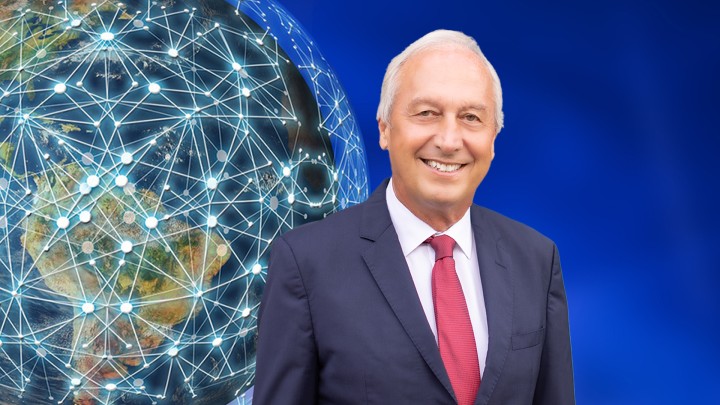Trading Secrets – online? The future of scientific leadership in an increasingly virtual environment

In 1989, when Tim Berners-Lee invented a ‘virtual room for interconnected information’ at CERN, the European Organization for Nuclear Research, it seems unlikely that the notion of an Amazon, Facebook or Netflix ever crossed his mind. He did not set out to reinvent global retail, social lives and entertainment. His ‘world wide web’ was intended to simplify the international exchange of scientific information.
Science, though, is global by nature, and over the centuries scientific endeavor has been fueled by the international exchange of ideas. Collaboration across borders continues to be an essential element in world-leading research. Exceptionally talented people have always understood that there is somebody outstanding from whom they can learn. The work of others inspires your own way of thinking and creativity. As Isaac Newton observed to Robert Hooke in 1675, researchers “stand on the shoulders of giants” to push science forward, collaborating and competing with colleagues around the globe.
In the early 1990s scientists were swift to embrace technology permitting instant communication and the easy exchange of ideas at low cost. Digitalization also allowed progress in video conferencing. Today, we exchange messages, articles, data and pictures, and discuss matters in real time, using our laptops and handsets. Instant communication is pivotal to the increase in collaboration and rapid spread of knowledge. The Royal Society noted that internationally collaborative articles published in leading journals had increased from 25% in 1996 to 35% in 2011. According to Buckminster Fuller, our knowledge in, for example, nanotechnology is doubling every two years. In clinical science this doubling of knowledge occurs every eighteen months. Increasingly, international cooperation is driven by the imperative to solve problems facing society in the 21st century, with scientists engaging peers and public alike through social media.
At a comparatively slower pace, organizations and those who manage them have begun to adopt virtual communication. There is still a good deal of persuasion required to convince administrators to rely on completely paperless and mobile offices. However, the COVID-19 global pandemic made virtual communication an immediate necessity. Digitalization was pushed forward in all areas of professional life, and working from home is the new normal in this time of crisis. At an international university on one of Japan’s southernmost islands, a thousand miles from Tokyo, managers at Okinawa Institute of Science and Technology (OIST) relied heavily on videoconferencing. This had been the case since the institution’s inception in 2004. Now, in a world combatting COVID-19, the university is functioning largely through the use of Zoom and similar platforms. Students, faculty and the public are all using these services to participate in webinars, online lectures and community engagement.
However, as a graduate university, OIST will not follow the example set by some US universities, which have opted to shift much of their activity online. In most cases, our researchers require laboratory infrastructure to deliver advanced education. Beyond the necessity of physical research facilities, we also believe strongly that virtual communication cannot adequately replace personal interaction. We have no intention of reducing it, at least in the short and medium term.
Those who work in internationally pre-eminent scientific institutions constitute one of the most globalized and intensively mobile group of people on the planet. To a political scientist and a biologist this comes as no surprise: as human beings we communicate and interact on many more levels than simply watching and listening in video conferences. Those of us who have tried to address an especially challenging matter over email will recognize in retrospect that talking and listening in person makes an immeasurable difference. If a video meeting gets tense, we all feel it is high time for a personal gathering. Motivating, coaching and mentoring can be done online, but you miss out on a great deal.
Our conditio humana is far more than functional, cognitive adults exchanging business information. Numerous studies have shown that human beings need to be together. Personal interaction sharpens motivation, conversation and even gossip help strengthen bonds, and the informal exchange of ideas outside of scheduled meetings can be every bit as valuable. Students and professors need the dynamic of the laboratory, which is not just a workplace but also place of social interaction. Creativity needs space to develop – offered by talk time between meetings, or efforts to solve problems over a cup of coffee. For this reason every good laboratory building is equipped with kitchen corners and cafeteria space. Unplanned personal interactions boost the potential for serendipity. People exchange their ideas from their specific expertise and perspective. You might encounter somebody who needs precisely the knowledge you possess. They are just waiting for your insight without even knowing it. Conferences curate inspiring conversation after lectures, prompting valuable dialog in coffee breaks, or sparking lengthy discussion over dinner. Events like those in the Keystone or Gordon portfolio bring people together not just for the scientific content, but to forge bonds through skiing or other pursuits. It is much easier to establish trust and rapport in this way.
Groundbreaking science is very often the result of trust. You share with somebody what you do, disclose the point you have reached, pose the questions you find most interesting, and reveal what bothers you, long before anything is published. Science is about trading secrets.
In adjusting to the global pandemic, the science world has shown that it can function virtually. Acceptable day to day management, and notable research advances, can still be achieved when we work at a distance from one another.
Our concern is for the momentum lost and opportunities missed in the virtual workplace. Leaders in science can strive to inspire, engage and guide their colleagues online, and things may seem perfectly adequate for a while.
True breakthroughs, though, can often arise from ideas first thrown around in casual discussion, or from collaborations which were completely unplanned and unscheduled. The barrier to this has risen.
Article commissioned by the Global Federation of Competitiveness Councils, September 2020.














